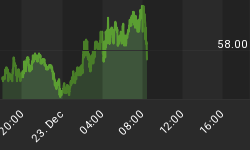
In summary, the U.S. annual goods and services deficit became wider in 2004, as reported by the U.S. Bureau of Economic Analysis and the U.S. Census Bureau, growing from $ 496.5 billion in 2003 to $617.7 billion in 2004, driven lower by imports increasing twice as quickly as exports. While there was an increase in exports in goods and services, imports continue to grow, across the geographic board (example: China: $124.1 B to $162 B, Japan: $66 B to $ 75.2 B and the European Union: $97.9 B to $110.0 B).
A fascinating text by Andy Kessler, "Running Money", suggests we should not be alarmed, thanks to the comparative advantage the U.S. has in developing both new technologies, new higher profit margin industries and future improvements in productivity. A virtuous economic cascade, described as a "waterfall" by Kessler, where costs of production and costs of goods and services become lower at home, are associated with the gradual export of certain low margin industries and jobs, the import of more and more cheaply produced goods and services, while new higher profit margin industries and jobs of the future are being created at home. AFL-CIO President John Sweeney offers a differing perspective, understandably, in his role of preserving certain jobs and industries of the present. Sweeney argued in a recent February10, 2005 press release that "America is beginning to lose its competitive edge in the high-tech, services, and agricultural sectors." The Cato Institute, on the other hand, argued in a January 11, 2005 piece from its Center for Trade Policy Studies, that some "negative" numbers could in fact mean "Good News on the Economy", after observing that U.S. economy performed better in years when the current account deficit, related to the trade deficit, a measure of the currency coming in versus out, was rising as a share of GDP, and did "especially well" in years when the current account deficit was "rising most rapidly", and that during years when the current account deficit shrank, unemployment actually rose. (The Current Account Deficit contains trade in goods and services, investment income earned abroad, and unilateral transfers. It excludes the capital account, which includes the acquisition or sale of securities or other property.)
While everyone is making sideways arguments about the big picture, we simply present a chart, and intend to cover the issue from an application point of view, e.g. trading. We submit respectfully and with our typical "uncertainty", that new jobs will be created over time in new industries that eventually will be sheltered and protected against the forces of change. We also suggest, however, that a "negative" trade deficit can be both bad as well as good, for economic growth. At some point, in the near term, corrective measures in the markets entail a painful blow to near-term growth, at least in the form of increased savings and hence less overall household borrowing, and therefore less spending on both imported and homegrown goods and services. Meanwhile, where are all those dollars going that we used to import so many overseas goodies and services?















